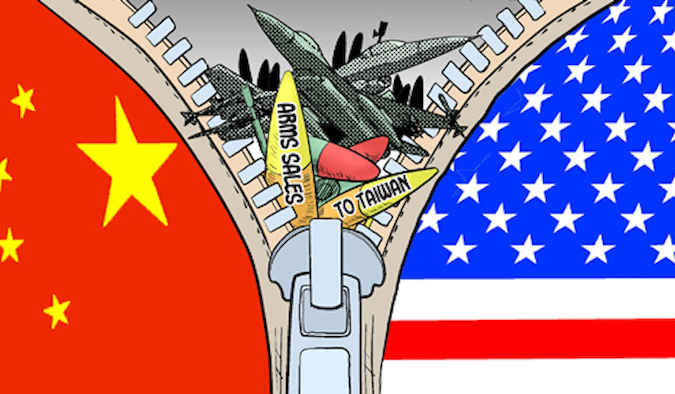By Aar Jay Persius
BERLIN (IDN) — U.S. President Joe Biden and Russian President Vladimir Putin reaffirmed at their June 16 summit in Geneva the principle agreed on by President Ronald Reagan and Soviet leader Mikhail Gorbachev in 1985, that “a nuclear war cannot be won and must never be fought”. They also decided to engage in a robust “strategic stability” dialogue to “lay the groundwork for future arms control and risk reduction measures”. [2021-07-01] INDONESIAN | JAPANESE | RUSSIAN
But, as the 2017 Nobel Prize winner, the International Campaign to Abolish Nuclear Weapons (ICAN), pointed out, “the outcome of the Geneva Summit does not reflect the gravity of current nuclear risks”. Presidents Putin and Biden, the ICAN adds, have made “no further commitments to reduce their nuclear arsenals, which would be in line with the UN Treaty on the Prohibition of Nuclear Weapons (TPNW) and global opinion”.
Russia (6,255) and the United States (5,500) together control 90% of the world’s nuclear arsenals SIPRI estimates at a total of nearly 14,000, which are many times more powerful than the nuclear weapon dropped on Hiroshima in August 1945. The other nuclear weapon states are the United Kingdom, France, China, India, Pakistan, Israel and North Korea. Thirty-one other states endorse nuclear weapons.
Daryl G. Kimball, Executive Director of the Arms Control Association, is of the view that the Geneva summit communiqué, albeit “modest and overdue is a vital recognition that the status quo is dangerous and unsustainable”. It is a chance for a course correction that moves the world further from the brink of nuclear catastrophe.
In a joint statement on strategic stability released following their June 16 meeting, the U.S. President and his Russian counterpart Putin further said the strategic stability dialogue would be “integrated,” “deliberate,” and “robust.” However, it remains to be seen to which extent each side will walk the talk. The U.S. and Russia appear to have different priorities for discussion in the upcoming strategic stability dialogue.
Biden said that the dialogue would “work on a mechanism that can lead to control of new and dangerous and sophisticated weapons that are coming on the scene now that reduce the times of response, that raise the prospects of accidental war.” He did not explain what specific weapons systems he has in mind.
Both presidents said, the date and location of the dialogue is not yet set but will soon be determined by officials at the U.S. State Department and, as Putin noted, by the Russian Foreign Ministry.
Arms Control Association’s Kingston Reif, Shannon Bugos and Hollis Rammer have drawn attention to what Russian Deputy Foreign Minister Sergey Ryabkov said at the Carnegie International Nuclear Policy Conference on June 22 that Moscow has proposed to Washington “as a first step a joint review of each other’s security concerns”.
The next step would be to “outline possible ways how to address these concerns,” with the goal being an agreed framework that “will be instrumental for further engagement in actual negotiations on eventual, practical agreements and arrangements”.
Significantly, the Geneva Summit Joint Statement marked the first step in a long-drawn-out process towards further progress on nuclear arms control after over a decade of deadlock. And this before the last remaining arms control agreement between the world’s two largest nuclear powers expires in five years.
The previous strategic stability dialogue was last held in August 2020 under the Trump administration in the lead up to the expiration of the 2010 New Strategic Arms Reduction Treaty (New START) in February. But two days before the treaty’s expiration, Biden and Putin agreed to extend New START by five years until 2026.
During a round of the strategic stability dialogue in June 2020, the United States and Russia agreed to form three working groups, which met in July of that year. A U.S. official at the time said that the topics for the working groups were nuclear warheads and doctrine; verification; and space systems.
Whether those groups have continued their work since then is unclear.
Arms control observers say that the strategic stability dialogue would be separate from any future negotiations on a potential arms control agreement to follow New START, but it could help set the foundation for those formal follow-on talks.
Rose Gottemoeller, chief U.S. negotiator of New START, emphasized in an op-ed in Politico on June 14 that the goal for the strategic stability dialogue should be “a good discussion rather than a treaty, although over time the two sides may agree to some measures to build mutual understanding, confidence and predictability”.
Concerning future negotiations on a replacement for New START, Gottemoeller urged Biden and Putin to “issue clear, simple guidance about what exactly the new treaty will cover and when it should be completed.”
Arms Control Association has refer to National Security Advisor Jake Sullivan’s remarks on June 10 that the Biden administration will aim to discuss “the very complex set of nuclear arms issues that face our two countries”. These include what may come after New START, “how do we deal with the fact that the INF Treaty is no more, [and] how do we deal with our concerns about Russia’s new nuclear systems”.
Signed in 1987, the INF Treaty led to the elimination of 2,692 U.S. and Soviet nuclear and conventional ground-launched ballistic and cruise missiles with ranges between 500 and 5,500 kilometres.
Washington has expressed its desire to address Russian nonstrategic nuclear weapons and bring China into the arms control process. Sullivan said that “whether additional elements get added to strategic stability talks in the realm of space or cyber or other areas, that’s something to be determined as we go forward”.
Russia’s Foreign Minister Sergey Lavrov said on June 9 that “anything that affects strategic stability must be discussed during a dialogue,” including “nuclear and non-nuclear, and offensive and defensive weapons.” Russia has, in addition, proposed the inclusion of not only China in arms control but also France and the United Kingdom.
His deputy, Ryabkov, told the Carnegie International Nuclear Policy Conference on June 22: “The parties may decide to adopt a package of interrelated arrangements and/or agreements that might have a different status if necessary. Moreover, it might be possible to design some elements in a way to make the room for others to join.”
The Chinese Foreign Ministry Spokesperson Zhao Lijian said on June 17, one day after the Geneva Summit: “China welcomes the agreement reached between the U.S. and Russia on engaging in a bilateral dialogue on strategic stability”.
He assured: “China always actively supports international efforts in nuclear arms control and will continue to hold discussions on a broad range of issues bearing on strategic stability with relevant parties within such frameworks as the cooperation mechanism of the five nuclear weapon states, Conference on Disarmament, and the UNGA [United Nations General Assembly] First Committee.”
He added: “We also stand ready to have a bilateral dialogue with relevant sides with mutual respect and on an equal footing.” A few days earlier, Chinese Foreign Minister Wang Yi had called for the five nuclear-weapon states to reaffirm the Reagan-Gorbachev principle that “a nuclear war cannot be won and must never be fought”. [IDN-InDepthNews – 01 July 2021]
Image: The US-Russia arms race. Source: china.org.cn




